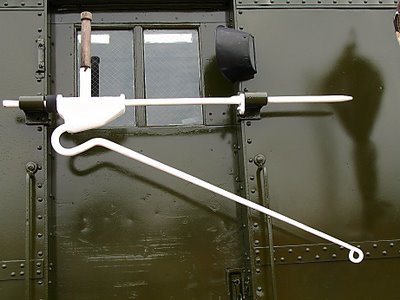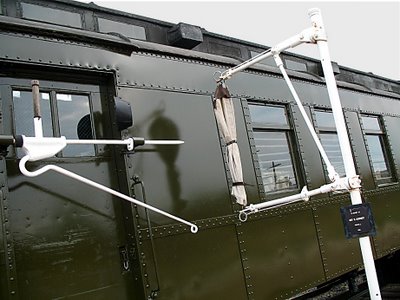It Takes a Lot to Laugh, It Takes a Train to Cry

This is a 4-6-4 type steam locomotive manufactured by Baldwin Locomotive Company in Philadelphia, PA. in the year 1930.
The picture does a poor job of conveying just how huge this is.
The engine and tender car are 93 feet in length and 15'10" tall. The tender car held 54,000 lbs. (27 tons) of coal and 15,000 gallons of water. (12,500 lbs) and together, the engine and tender weighed 728,920 pounds (364 tons).
And amazingly, as far back as 70 years ago it could speed passengers across the countryside at a top speed of over 110 mph!


Before being retired around 1960, this locomotive logged an amazing 2,348,267 miles.
That's the equivalent of going to the moon and back 5 times, traveling 94 times around the earth at the equator, or 838 times the driving distance from New York to Los Angeles.
Now that you know more than you ever wanted to know about this massive and amazing piece of rail history, who can tell me where it's located?
(Hint: It's within an hour of the Quad Cities.)
And for extra double fantastic bonus points, what is device shown below and what was it used for? (No fair if you've been there and have seen it.)

**Update** Esteemed fellow blogger Dave Barrett correctly identified the picture above. It's a gizmo on a mail car which they used to snag mail bags hung from posts in small towns as they flew past. A pretty ingenious system.
Here's a picture showing the post used to hang the bag. I'm still not sure of how the latches and releases worked, nor can I figure out what the rods with the loops in the end were for. I'm also not sure what kept the heavy bag from sliding through the crook of the snagger. You'd think the pole would be mounted on a spring or the arm would be able to rotate, but it's rigid. And I'm not sure why the leading point of the snagger thing is pointed. I'll have to do a bit more research. (as if anyone but me cares. ha!)
















11 Comments:
I have no idea where that is but on the bonus question that looks to me like it might have been used to snag bags of mail at places where the train did not stop.
Excellent Dave... you are indeed correct.
Believe it or not, someone would stand in the doorway and look out the little windshield thing, then as the train sped past, pull on the wooden handle to extend the clothespin like hook. It would then snag the mail bag which was hanging from a specially designed poll.
I'll post a picture showing the two together.
Just curious though, what made you think it was for snagging mail? Were you familiar with the fact that they used to do that?
I'd never seen it before and it blew me away. How ingenious! And what a fun job. (except maybe when it was below zero) ha!
Yes, I had heard that they used to do that. Before my time, of course, but I had read about it. During the 19th Century and into the early 20th Century railroads were the first and often the only way to get people, freight and mail to most places. Moving the mail between cities by truck and airplane is very much a 20th Century development.
Besides picking up the mail from places along the route where they would not stop using the pictured device they would also toss mail bags off the train to a fellow waiting on the platform. (Probably the same fellow who stuck the outgoing mail bag on that pole.) They didn't need a special device for tossing the mail from the train to the platform, just good timing. The Post Office would have mail sorting cars on some trains for sorting the snagged mail, so that mail they picked up in one town could be added to the mail bags they were tossing off at the next, if that was where it was going.
It was all very high-tech for its time.
I find it all pretty fasinating and it really captures my imagination.
Think of working on a swaying railroad car equipped with hundreds of cubby holes and sorting mail as the train rocks through the night.
And the other thing that I find incredible is the locomotive itself.
They're, along with perhaps the ocean liners of the day, the height engineering of the "iron age". Their sheer size represents just how audacious and ambitious it must have been to even think something like it could be designed, built, and run.
They're outrageously complex, yet crude at the same time. Material strength was gotten by sheer mass. If you needed something which could withstand incredible stress and pressure, just make it huge. If that piece weighed several tons, then make everything else bigger to support it.
Little attempt to shave weight and no materials more advanced than simple steel and iron, rivets, rods, bolts and pipes.
The sheer amount of iron and steel that needed to be produced to make one locomotive like this is staggering, let alone the fact that there were thousands of them in operation and millions of miles of track.
There were no electronics more sophisticated than a big wire running up to the headlamp on the front of the train. There's not one speck of plastic on the entire machine.
Everything was mechanical, and huge. Yank a lever or turn a wheel or valve. Everything was directly connected and you could feel everything.
There's a dizzying amount of parts, each which had to be designed and engineeered and mined, poured, and molded, and then actually put together, then kept lubricated, tightened, and replaced if it broke or wore out.
And the fact that all the thousands of huge heavy parts worked together, and not only that, but performed for decades and literally millions of miles, and was so finely put together that it could run at 100 mph plus, just boggles my mind.
I find it amazing also. Of course, that steam engine was the end product of more than 200 years of innovation and improvement, with hundreds of engineers, designers and manufacturers, each adding their own new improvement and enhancement, building on the previous designs. Just in the short period of a few hundred years you see what a magnificent, huge and complex thing can arise from a series of small incremental changes and improvements. Evolution is marvelous and powerful.
Dave, TID,
I can't resist...
...was it "evolution," or "intelligent design." ;-)
I think it was "revolution", the industrial revolution.
The steel industry in Pennsylvania must have been on a scale dwarfing almost any industry today.
The railroads grew with the country at a time when both the land, the resources, and the money to be made seemed to have no limit.
Guess you missed my wise guy reference to the silly debate about teaching science in public schools.
Huck,
No, I caught that, but I wasn't sure if the smart aleck faded in and out and where... haha!
Being such a degenerate smart ass myself, I certainly should be better at detecting it.
They were not steam. But we used to take the Rocket from Moline to Chicago. Can you get photos of that? The Rocket using the Rock Island Lines had Porter cars.
Shalom,
--- Leland Milton Goldblatt, Ph.D. ®
Distinguished Professor
Prairie Dem, you're correct.
This locomotive and a lot more are located at Galesburg's new Railroad Museum that features several outdoor exhibits including a Pullman car and other stuff as well as a new museum building next to the Amtrak station.
Worth a visit.
Post a Comment
<< Home